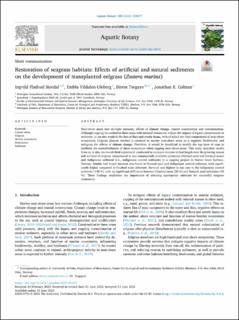| dc.contributor.author | Størdal, Ingvild | |
| dc.contributor.author | Uleberg, Embla Vildalen | |
| dc.contributor.author | Alemu, Diress Tsegaye | |
| dc.contributor.author | Colman, Jonathan Edward | |
| dc.date.accessioned | 2023-10-04T07:49:37Z | |
| dc.date.available | 2023-10-04T07:49:37Z | |
| dc.date.created | 2023-06-30T14:00:35Z | |
| dc.date.issued | 2023-06-19 | |
| dc.identifier.citation | Størdal, I. F., Uleberg, E. V., Tsegaye, D., & Colman, J. E. (2023). Restoration of seagrass habitats: Effects of artificial and natural sediments on the development of transplanted eelgrass (Zostera marina). Aquatic Botany, 188, 103677. | en_US |
| dc.identifier.issn | 0304-3770 | |
| dc.identifier.uri | https://hdl.handle.net/11250/3094014 | |
| dc.description.abstract | Near-shore areas face multiple stressors, effects of climate change, coastal construction and contamination. Although capping the seabed in these areas with mineral masses can reduce the impact of legacy contaminants in sediment, it can also result in the loss of flora and sessile fauna, both of which are vital components of near-shore ecosystems. Eelgrass (Zostera marina) is essential to marine near-shore areas as it supports biodiversity and mitigates the effects of climate change. Therefore, it would be beneficial to modify the top layer of caps to facilitate the reestablishment of these ecosystems when capping near-shore areas. This study describes results from an in situ, six-month field experiment conducted to compare increase in leaf length over the growing season and survival of eelgrass transplanted in two commercially available substrates (Natural sand and Crushed stone) and indigenous sediment (i.e., indigenous control sediment) in a capping project in Horten Inner harbour, Norway. Similar leaf length increase was found in Natural sand and Indigenous control sediment, both significantly higher compared to Crushed stone substrate. Survival was highest in our case in the Indigenous control sediment (120 %), with no significant difference between Crushed stone (20 %) and Natural sand substrates (25 %). These findings emphasize the importance of selecting appropriate substrate for successful seagrass restoration. | en_US |
| dc.language.iso | eng | en_US |
| dc.publisher | Elsevier B.V. | en_US |
| dc.rights | Navngivelse 4.0 Internasjonal | * |
| dc.rights.uri | http://creativecommons.org/licenses/by/4.0/deed.no | * |
| dc.title | Restoration of seagrass habitats: Effects of artificial and natural sediments on the development of transplanted eelgrass (Zostera marina) | en_US |
| dc.title.alternative | Restoration of seagrass habitats: Effects of artificial and natural sediments on the development of transplanted eelgrass (<i>Zostera marina</i>) | en_US |
| dc.title.alternative | Restoration of seagrass habitats: Effects of artificial and natural sediments on the development of transplanted eelgrass (Zostera marina) | en_US |
| dc.type | Peer reviewed | en_US |
| dc.type | Journal article | en_US |
| dc.description.version | publishedVersion | en_US |
| dc.rights.holder | © 2023 The Author(s) | en_US |
| dc.source.pagenumber | 4 | en_US |
| dc.source.volume | 188 | en_US |
| dc.source.journal | Aquatic Botany | en_US |
| dc.identifier.doi | 10.1016/j.aquabot.2023.103677 | |
| dc.identifier.cristin | 2159937 | |
| dc.source.articlenumber | 103677 | en_US |
| cristin.ispublished | true | |
| cristin.fulltext | original | |
| cristin.qualitycode | 1 | |

